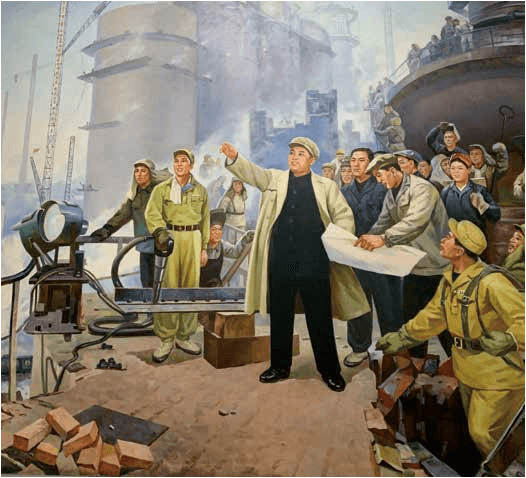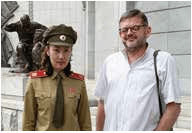Issue:

A mural in a train station aims to instil positivity in the populace—and in visitors?
Is North Korea loosening its restrictions on foreign visitors? Or just wooing them with more of the comforts of home?
By Simon Farrell
Could North Korea’s bullish tourism slogan of “See you in Pyongyang” mean the secretive dictatorship is warming to visitors?
On a recent trip, I found the rules and people remarkably relaxed. As expected, we were not allowed to leave our hotel grounds (one on an island, the other in a gated compound) without an official guide. But we spent much of the last 48 hours unescorted at a trade fair and on the Beijing bound overnight train.
Yes, I was obliged to dress well and bow deeply at revered monuments to supreme or eternal leaders. But before we visited the ghoulish, garish mausoleum of the country’s first two leaders Kim Il-sung and his son Kim Jong-il an Australian member of our group politely declined due to his Christian sensitivities and was happily allowed to stay on the bus.
Taking photographs of almost anyone, anywhere, at any time, was allowed subject, naturally, to asking first. And I learned how to legally shake off your guide and obtain unlimited cheap global internet without causing trouble or offence.
We could even call abroad from our hotel room and keep our cameras, cellphones, laptops, notebooks, pens, recorders and any other devices or instruments, if declared on entry.
FROM TOKYO, I APPLIED for a North Korean visa by paying a refundable (if visa is declined) deposit online with a specialist travel agent in Beijing. The all inclusive trip was marketed as featuring Pyongyang’s signature Mass Games, International Film Festival, and Autumn Trade Fair, plus the Korean Demil itarized Zone, restaurants, cultural sites and monuments.
As the trip went through Beijing, the next step was to go to the Chinese Visa Application Service Center, in Toranomon. After I asked for a double entry visa to transit China via North Korea, the official said: “Why do you want to go there? Terrible place North Korea. Don’t steal any ashtrays or paintings from the hotel like that American did.” He meant the tragic case of student Otto Warmbier, who died in 2017 of botulism or torture according to conflicting accounts after being repatriated in a coma 15 months into his 15 year sentence of hard labor for attempting to steal a picture.
I was mildly rebuked during my visa interview for writing “Hong Kong” under “previous countries visited” rather than “China (Hong Kong).” When my interrogator saw “media” in my company name, I thought the game was up. But she kindly compromised by asking me to write and sign two letters detailing my job and pledging not to work in China.
My North Korean visa was waiting in Beijing the day before my flight to Pyongyang on North Korea’s state owned Air Koryo. The airport queue for the 90 minute flight was barefaced sanction busting: huge parcels of tightly wrapped consumables and commodities had formed tidy lines before any passengers arrived. Every Korean checking in looked laden down with at least three times the baggage allowance.
AT CLEAN, SPACIOUS, AND efficient Pyongyang International Airport, easy going officials smilingly eased me through a throng of Chinese tourists at customs, barely glancing at my bags and quickly stamping my tourist visa card.
The 20 minute bus drive to the 47 story Yanggakdo International Hotel set the tone for much of what we saw of Pyongyang spotless with fresh flowers decorating apartment and shop balconies, and pavements full of well dressed pedestrians. Luxury European and Asian cars vied with electric bicycles. Charm offensive or typical airport route?
The hotel façade was a thin, shiny metal and glass frontage concealing a rough stone eyesore of reality. The spacious lobby was bright and airy, but gloom set in as we entered the shabby lift. There was no button for the mysterious fifth floor, said to house spies who operate secret cameras in some guest rooms. But my local source claimed that Otto admitted in court stealing the picture of Dear Leader Kim Jong-un from the staff only second floor, not the also off-limits fifth floor, as widely reported.

The author at the border
Spying onguests is a myth, anyway, claim some tourism industry insiders. Authorities have a much more effective tool to control tourists and discourage espionage or journalists: keep visitors busy and tire them out with early power breakfasts, whirlwind tours, boozy lunches and late dinner movies. Then it’s back to the room for Al Jazeera English TV’s take on global affairs and local news and dramas controlled by the government’s Propaganda and Agitation Department. No time for naps, let alone a rendezvous or dead drop.
Our promised tickets for the 17th Pyongyang International Film Festival red carpet opening ceremony never materialized. We got instead sincere apologies, official goody bags, and a private showing of Comrade Kim Goes Flying in a cavernous art deco cinema decorated with North Korean propaganda and film posters.
AT DINNER, ONE QUITE professional guide seemed well briefed on global issues but angry about Japan; she was convinced that Tokyo was lying about its citizens being kidnapped. The often credible sounding guides occasionally let themselves down with claims such as: “There is no crime in North Korea because we teach our children manners, respect and honesty.”
The same charming guide casually pumped me over beers about my job, passport, life, and family, until I showed her a photo on my cellphone; she then quickly and expertly swiped through dozens of my images uninvited and out of my reach. Just curious, a cultural thing, or something sinister?
One of our group got quite mouthy with the same guide, but it was soon forgotten. Guides often try to divert tourists to softer destinations such as UNESCO sites, Buddhist temple, souvenir shops, and more monuments. But they are hard sells competing with more interesting sites.
Pyongyang’s marbled subway claims the world’s longest murals, deepest escalators, and cheapest tickets. At the Korean Demilitarized Zone, where the Korean Armistice Agreement was signed to cease hostilities in 1953, one can endure loud lectures on “American Imperialism.” The uneventful three hour drive from Pyongyang, with farmers and builders toiling alongside the pothole scarred road, was our only rural view of the week.
Then there’s the Victorious Fatherland Liberation War Museuman eerie monument to perceived injustices and victories. You are seated on a moving 360 degree journey around a movie set like bloody battleground, with graphic exhibits of captured enemies’ personal and military items.
WHO COULD PASS UP a visit to the Kumsusan Palace of the Sun to see the preserved remains of Kim Il-sung and Kim Jong-il lying in state, bathed in blood red light inside their transparent crystal sarcophagi? An estimated 1.5 kilometer long subterranean moving walkway closely monitored by static soldiers and secret service types glaring through sinister dark shades glides foreign visitors and selected North Korean high achievers at funeral pace through bizarre wet shoe cleaners and power ful full body air blowers (to remove dust and detect hidden devices) into a somber and grey zone of utter silence.
In groups of four, everyone must bow at the feet and sides of both bodies in separate chambers. Adjoining rooms display hundreds of their possessions: mementos, uniforms, arms, gifts, medals, images and awards from governments, universities and organizations mostly from communist countries or other dictatorships: Gaddafi, Castro, Zhedong, Ceaușescu, Tito, Stalin, Khrushchev, Arafat, Guevara. Africa is well represented, especially Nigeria, but noticeably not South Africa. Peru gets many mentions. There’s also a Peace Medal from Japan and a photo with former visiting US President Jimmy Carter.
On the last day, I orchestrated a mini revolt by asking everyone if they really could take any more temples, monuments and facades. No! I sold this to our long suffering guide by gently explaining that we had democratically voted in a democratic country: she laughed and set us free. Well, almost.
We wandered the Pyongyang International Autumn Trade Fair for two hours, guideless, rather than the 15 minutes under escort as originally planned. I was allowed to forego the group dinner and movie in exchange for sundowners with another guide in my hotel’s top floor revolving restaurant. We were rewarded with a breathtaking 360 degree dusk view of egrets and ibis silhouetted against the 12 minute rush hour and murky Taedong River, both slowly snaking through the barely lit pastel painted suburbia.
In the lift going down, a young Westerner told me free Wi-Fi was accessible in the casino. It was deep in the bowels of the hotel, one of the country’s three casinos. It warms up about 8pm, shuts at 3am, and is smoky and noisy. But the big draw is unlimited Wi-Fi if you spend (and lose) just $10.
And so I sat until closing time, sending and receiving LINE and email messages and enjoying the BBC, Japan News and just googling, apparently without censorship or monitoring. With my guide’s proud boast still ringing in my ears that “North Korea doesn’t have Internet; we have Intranet,” I was delighted to swap messages and images with several surprised Tokyo compatriots after a week of online silence.
Of course, revealing these hacks to hacks so openly like this may result in the authorities closing such loopholes. But by not revealing them, nobody would know and nothing would be gained, right?
I did feel that like Vietnam, China and Cuba before them North Korea is loosening up because it knows that hard currency visitors require certain freedoms and respect, and that it’s pointless denying them the basics they enjoy at home.
Simon Farrell is publisher and editor in chief of Mansion Global Japan, BCCJ ACUMEN, ACCJ Journal and The Canadian at Custom Media.

